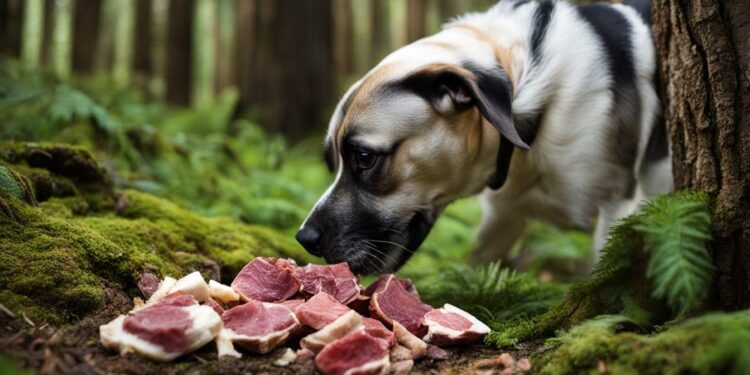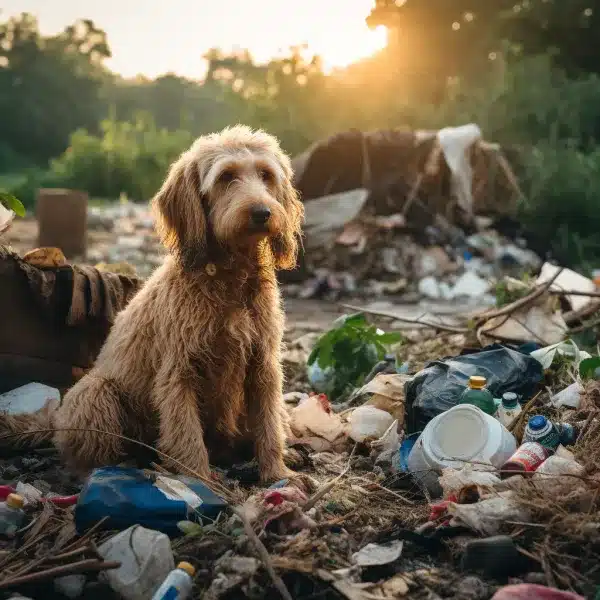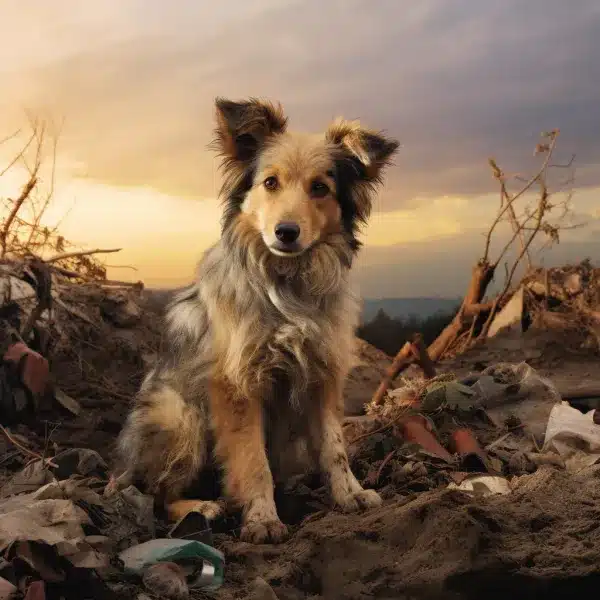Canine Conservation: Dogs’ Role In Environmental Protection

Dogs In Environmental Conservation: Dogs play a vital role in environmental conservation, using their exceptional skills and instincts to protect and preserve our planet. With their strong sense of smell, dogs have been instrumental in various conservation efforts. They have been trained to track and monitor threatened and endangered species, assisting in wildlife conservation. By detecting the feces of animals such as tigers, orcas, bears, and wolves, dogs provide valuable information for researchers studying their health and DNA.
In the fight against illegal wildlife trading, specially trained dogs have been deployed to sniff out tiger parts, elephant ivory, rhino horns, and other endangered species products. Their efforts have been crucial in the battle against wildlife trafficking and illegal hunting. Dogs have also proven to be invaluable in anti-poaching operations, particularly in Africa, where they help track down poachers and protect elephants, rhinos, and lions.
Dogs can help protect the environment by detecting harmful species and diseases, which prevents their spread and protects ecosystems. Owning dogs also encourages people to spend more time outside and appreciate nature, which can lead to a desire to conserve natural environments. Supporting organizations that use conservation dogs and taking steps to prioritize the environment can make a difference.
Dogs in Wildlife Conservation

They have a strong sense of smell that helps researchers track and monitor endangered animals. By detecting various scents, dogs provide important data about animal presence, behavior, and population size. Dogs are especially helpful in locating elusive species in dense forests and remote areas. They follow scent trails left by animals like tigers, wolves, and bears. This helps researchers monitor movements and gather crucial information about habitats and behaviors. This data assists in developing effective conservation strategies to safeguard endangered species.
Dogs can find the poop of different animals. Scientists use this poop to learn about animals’ health, diet, and genes. This helps us understand how animals live and what threatens them. For example, dogs can find orca poop and help us study their diet and health in the ocean. Dogs are helpful for protecting wildlife. They can go to places that people can’t and find important information. Dogs are important partners for researchers and conservationists who want to keep animals safe for the future.
Fecal Detection and Research
Specially trained dogs can detect and identify the feces of animals such as tigers, orcas, bears, and wolves, providing researchers with crucial data for wildlife research and conservation. Through their exceptional sense of smell, these canine conservationists are able to locate and identify specific scents, allowing scientists to study the health, diet, and DNA of various species.
In a study conducted by the Wildlife Conservation Society, dogs were trained to detect the scat of endangered Amur tigers in the Russian Far East. This enabled researchers to accurately estimate population size, monitor changes in habitat use, and gather important information for conservation efforts. Similarly, dogs have been employed to help study orca populations in the Pacific Northwest, where their ability to locate whale scat has provided valuable insights into the health and reproductive success of these marine mammals.
By utilizing dogs in fecal detection and research, conservationists are able to gather non-invasive data that would be otherwise difficult or time-consuming to obtain. This method not only helps scientists understand the ecological needs of various species, but it also contributes to the development of effective conservation strategies and the protection of their habitats.
| Benefits of Fecal Detection by Dogs: |
|---|
| Accurate population estimation |
| Monitoring changes in habitat use |
| Identification of individual animals |
| Study of reproductive success |
| Insights into diet and health |
Through their remarkable olfactory abilities, dogs are instrumental in collecting valuable data that contributes to our understanding of wildlife populations and their conservation needs. Supporting organizations that train and employ these conservation dogs, as well as taking actions to prioritize the environment, can help ensure a sustainable and healthy ecosystem for future generations.
Combating Illegal Wildlife Trading
Specially trained dogs have been instrumental in combating illegal wildlife trading, as they can detect tiger parts, elephant ivory, rhino horns, and other endangered species products. Their incredible sense of smell makes them invaluable in identifying hidden wildlife contraband, aiding law enforcement agencies and conservation organizations in their efforts to protect vulnerable species and ecosystems.
These clever canines undergo rigorous training programs to become skilled at sniffing out illegal wildlife products. They are taught to recognize the unique scent profiles of endangered species and are able to differentiate between legal items and those derived from poaching activities. By strategically deploying these highly trained dogs at ports, borders, and other key transit points, authorities can intercept illegal wildlife shipments and apprehend traffickers.
“The use of dogs in combating illegal wildlife trading is a proactive and effective measure. These remarkable animals are able to locate hidden wildlife products, which would otherwise go undetected, enabling law enforcement agencies to bring poachers and traffickers to justice.” – Dr. Jane Wilson, Conservation Expert
The impact of these canine conservationists goes beyond the immediate seizure of contraband. Their presence acts as a deterrent to would-be traffickers, significantly reducing the demand for illegal wildlife products. By disrupting the supply chain, these dogs help to disrupt and dismantle criminal networks involved in the illicit wildlife trade.
Supporting organizations that employ and train conservation dogs, as well as taking action to promote responsible tourism and sustainable practices, allows individuals to contribute to the fight against illegal wildlife trading. By raising awareness about the role of dogs in environmental conservation and the devastating effects of the illegal wildlife trade, we can work together to protect endangered species and preserve our natural world for future generations.
| Key Facts: Combating Illegal Wildlife Trading |
|---|
| – Specially trained dogs can detect illegal wildlife products such as tiger parts, elephant ivory, and rhino horns. |
| – Their strong sense of smell enables them to locate hidden contraband, aiding in the interception of illegal wildlife shipments. |
| – The presence of conservation dogs acts as a deterrent, reducing the demand for illegal wildlife products. |
Dogs in Anti-Poaching Efforts
In the battle against poaching, dogs play a crucial role in tracking down poachers and preventing the illegal hunting of critically endangered species like elephants, rhinos, and lions. Their exceptional sense of smell and agility make them invaluable assets in anti-poaching operations, particularly in Africa.
These highly trained canines, often Belgian Malinois or German Shepherds, work alongside rangers and conservationists to patrol protected areas and detect human scent, weapons, and illegal wildlife products. Through their keen sense of smell, dogs can track poachers across vast distances, even in challenging terrains such as dense forests or vast savannas.
Additionally, dogs provide a deterrent effect, as their presence alone can discourage potential poachers from entering protected areas. Their unwavering loyalty and courage make them trusted companions to rangers, providing an added layer of protection for both wildlife and human teams.
| Benefits of Dogs in Anti-Poaching Efforts |
|---|
| – Enhanced tracking abilities through their acute sense of smell |
| – Increased efficiency and success rates in apprehending poachers |
| – Improved safety for rangers through early detection and deterrence |
| – Protection of critically endangered species from illegal hunting |
| – Promotion of community engagement and awareness in conservation efforts |
The collaboration between humans and dogs in anti-poaching efforts has proven to be highly effective in safeguarding wildlife populations and their habitats. By supporting organizations that train and deploy these canine conservation heroes and taking action to protect the environment, we can ensure a sustainable future for our planet’s most precious species.
Detection of Invasive Species and Diseases
Dogs’ exceptional scent detection abilities have been harnessed to identify invasive species and diseases, helping in the protection of ecosystems and native species. These highly trained canines play a crucial role in biosecurity and the preservation of habitats.
When it comes to invasive species, dogs have been trained to detect the presence of harmful plants, insects, and animals. By sniffing out these invasives, dogs can help prevent their spread and the negative impacts they have on native ecosystems. Their keen noses can uncover hidden invasives like the destructive zebra mussels or the invasive Japanese knotweed, which can displace native plant species.
In addition to invasive species, dogs are also trained to detect diseases that pose a threat to wildlife and humans alike. For example, they can identify the presence of deadly diseases like the white-nose syndrome, which affects bat populations, or the chytrid fungus that has been devastating amphibian populations worldwide. By detecting these diseases early, dogs assist researchers and conservationists in implementing necessary measures to prevent further spread.
| Invasive Species Detected by Dogs | Diseases Detected by Dogs |
|---|---|
| Asian Longhorn Beetle | Chytrid Fungus |
| Zebra Mussels | White-nose Syndrome |
| Japanese Knotweed | Avian Influenza |
The use of dogs in detecting invasive species and diseases not only helps protect ecosystems but also aids in the preservation of native species. By identifying and managing these threats effectively, we can work towards maintaining the delicate balance of our natural environments.
Dog Ownership and Environmental Awareness
This enhances your dog’s physical and emotional health and shows you the outdoors’ splendor. Dogs are naturally curious, and as their human friend, you get to see their joy and enthusiasm as they explore nature.
Spending time with your dog outdoors increases your awareness of nature. The sights, sounds, and fragrances make you appreciate Earth’s complex ecosystems. This increased awareness frequently inspires a desire to preserve these places for future generations. As an environmental champion, you may participate in clean-ups, assist local conservation organizations, or educate others about environmental care.
Owning a dog helps the environment. Good dog owners get rid of dog poop properly so it doesn’t hurt the environment. Some dog owners use eco-friendly products. By being careful, you can help the environment and show others how to do it too. When you go outside with your dog, you’re helping the environment. Owning a dog helps you enjoy nature and care for it. Have fun and help the earth!
Supporting Organizations and Conservation Dogs
By supporting organizations that utilize conservation dogs, you can actively contribute to environmental conservation and make a difference in protecting our planet. These organizations play a crucial role in training and deploying highly skilled canines for various conservation efforts. Whether it’s tracking and monitoring endangered species, detecting illegal wildlife products, or combating poaching, these dogs are at the forefront of the fight to preserve our natural world.
One such organization is the Conservation Canines, which trains dogs to detect the scat, or feces, of different animal species. This valuable information helps researchers study population dynamics, monitor animal health, and gather data on DNA and hormones. The Center for Conservation Biology also employs conservation dogs to locate and study endangered species, including wolves and whales, providing critical insights into their behavior and conservation needs.
In the fight against illegal wildlife trading, organizations like Working Dogs for Conservation train dogs to sniff out products made from endangered species, such as tiger parts, elephant ivory, and rhino horns. These specially trained dogs have been instrumental in intercepting illegal wildlife products, disrupting trafficking networks, and raising awareness about the devastating impact of wildlife trade on biodiversity.
| Benefits of Supporting Conservation Dogs Organizations: |
|---|
| 1. Directly contribute to environmental conservation efforts |
| 2. Help protect endangered species from poaching and illegal wildlife trade |
| 3. Support scientific research and data collection for wildlife conservation |
| 4. Promote awareness about the importance of conserving natural habitats |
By supporting these organizations and their canine conservation efforts, you can play an active role in protecting our planet’s biodiversity and ensuring a sustainable future. Whether through donations, volunteering, or simply spreading the word, every action makes a difference. Together, we can create a world where dogs and humans work hand in paw to safeguard our environment for generations to come.
Taking Action for the Environment
There are several steps you can take to prioritize the environment and support the conservation efforts related to dogs and the environment. By adopting eco-friendly practices and making conscious choices, you can make a positive impact on our planet.
1. Embrace Sustainable Dog Products
When it comes to your furry friend, opt for eco-friendly dog products. Look for pet supplies made from sustainable materials, such as bedding crafted from organic cotton or toys made from recycled materials. Consider purchasing food and treats that are sourced ethically, with minimal packaging waste.
2. Practice Responsible Waste Management
Properly dispose of your dog’s waste by bagging it and placing it in designated waste bins. Dog waste can pollute water sources and harm wildlife if not managed correctly. If you prefer a more sustainable option, you can use biodegradable waste bags or explore composting options specifically designed for pet waste.
3. Support Conservation Organizations
Contribute to the conservation efforts by supporting organizations that train and deploy dogs for environmental conservation purposes. These organizations rely on donations to continue their vital work. Consider donating funds or volunteering your time to help support their initiatives.
4. Advocate for Responsible Pet Ownership
Spread awareness about the importance of responsible pet ownership and its connection to environmental conservation. Encourage others to adopt, rather than buy, pets from shelters. Promote the sterilization and vaccination of pets to prevent overpopulation and the spread of diseases.
| Actions to Take | Benefits |
|---|---|
| Choose eco-friendly dog products | Reduce carbon footprint and waste |
| Practice responsible waste management | Protect water sources and wildlife habitats |
| Support conservation organizations | Contribute to conservation efforts and research |
| Advocate for responsible pet ownership | Prevent overpopulation and promote pet welfare |
Remember, every small action counts. By making conscious choices in your daily life and supporting organizations dedicated to the conservation efforts involving dogs and the environment, you can help create a more sustainable and healthy world for generations to come.
The Connection Between Dogs and Conservation
Dogs are loyal and dedicated to environmental conservation. They are helpful in conservation efforts because of their unique abilities. Dogs are useful in tracking and monitoring endangered species due to their sense of smell. They can detect scents beyond human capability and locate elusive wildlife across vast landscapes. Dogs are also trained to detect and identify feces to aid researchers in studying animal health and DNA. This information helps scientists understand animal population dynamics, habitat requirements, and overall well-being, leading to effective conservation strategies.
| Dogs in Conservation | Role |
|---|---|
| Wildlife Conservation | Tracking and monitoring endangered species |
| Fecal Detection and Research | Identifying animal scat for studying health and DNA |
Dogs are important for stopping illegal wildlife trading. They are trained to find hidden items like tiger parts, ivory, and rhino horns. This helps officials catch people who are trading these items illegally. Dogs are also helping to protect animals in Africa from being hunted illegally. They track down poachers and help catch them quickly. By stopping poachers, dogs help keep vulnerable species safe and protect ecosystems.
Connection and Collaboration
The connection between dogs and conservation extends beyond their practical contributions. Owning a dog fosters a greater appreciation for nature and the environment. Daily walks and outdoor activities with our furry companions increase our exposure to the natural world, sparking a sense of wonder and encouraging personal responsibility for its conservation.
“The bond between humans and dogs has the potential to create a powerful force for environmental change.” – Jane Goodall
Environmental conservation can also be achieved by supporting conservation dog organizations. Public awareness and engagement sustain these critical organizations. Individuals may protect the earth by advocating for their cause and participating in sustainable efforts.
Dogs’ outstanding abilities and unshakable dedication make them ideal environmental conservation partners. Dogs help preserve our planet’s biodiversity and delicate ecosystems by locating endangered animals, detecting wildlife products, fighting poaching, and fostering a love of nature.
Benefits of Canine Conservation Efforts
Including canines in conservation projects improves efficiency, cost-effectiveness, and success rates. In animal conservation, dogs’ keen sense of smell and tracking skills help monitor and protect endangered species. Dogs can detect animal feces in addition to tracking, giving researchers with important health and DNA data. Non-invasive fecal detection is efficient and reduces stress and injury to animals being investigated.
| Benefits of Canine Conservation Efforts |
|---|
| Enhanced Efficiency |
| Cost-Effectiveness |
| Higher Success Rates |
Trained dogs are essential in fighting wildlife trafficking and poaching. Their capacity to detect tiger parts, elephant ivory, and rhino horns has helped battle these illegal operations. Dogs have helped save elephants, rhinos, and lions in Africa by locating poachers.
To safeguard environments and biosecurity, dogs are trained to identify invading species and diseases. Their ability to identify and pinpoint dangers enables for timely response, stopping the spread of exotic species and disease outbreaks that might devastate ecosystems.
Dog ownership helps raise environmental awareness by encouraging outside activities and natural connection. Dog owners tend to value nature and want to preserve it. Supporting conservation dog organizations and practicing eco-friendly activities help protect a healthy ecosystem.
The Future of Dogs in Environmental Conservation
Dogs are becoming increasingly important in environmental conservation due to advancements in training and understanding their abilities. They have already proven to be valuable in various conservation efforts and have the potential for even greater impact. One area where dogs can be useful is in developing new detection techniques to identify invasive species and diseases. They can provide early detection and prevention measures that can benefit conservation efforts. Dogs can also play a crucial role in public engagement and awareness by showcasing their work and highlighting the connection between dogs and the environment. This can inspire individuals to make eco-friendly choices and support sustainable initiatives.
Benefits of Dogs in Environmental Conservation
| Benefits of Dogs in Environmental Conservation |
|---|
| Increased efficiency in wildlife tracking and monitoring |
| Cost-effective solutions for combating illegal wildlife trading |
| Improved success rates in anti-poaching efforts |
| Enhanced biosecurity and habitat preservation through the detection of invasive species and diseases |
| Promotion of outdoor activity and a greater appreciation for nature through dog ownership |
As the field continues to evolve, collaboration between humans and dogs will be key. By fostering partnerships between conservation organizations, researchers, and dog trainers, we can maximize the potential of canine contributions to environmental conservation. Sharing knowledge, resources, and best practices will help refine training techniques and expand the applications of dogs in protecting and preserving our planet.
Public Engagement and Awareness
We need to increase public awareness about how dogs help the environment for a more eco-friendly society. This can inspire people to support these efforts. Education and outreach programs can be effective in engaging the public. We can educate people about how dogs track endangered species, detect illegal wildlife trading, and fight poaching. This can showcase the abilities of these dogs and motivate people to get involved.
Tables and visuals are useful for showing how dogs help environmental conservation. A table can list wildlife that dogs protect and which organizations use them. This helps people understand their contributions and reminds us to protect biodiversity.
| Type of Wildlife | Conservation Organization |
|---|---|
| Endangered Species | Save the Rhinos Foundation |
| Illegal Wildlife Trading | Wildlife Conservation Society |
| Invasive Species | National Parks Service |
Using personal stories and quotes from people who have seen the benefits of dogs in conservation can help connect with the public. This can inspire them to support organizations that use conservation dogs or take action in their own communities. By raising awareness, we can encourage people to become environmental stewards and advocates for using dogs in conservation. This will create a better future for both humans and animals.
Collaboration between Humans and Dogs
Humans and dogs working together can help protect the environment for future generations. Dogs have unique abilities that make them valuable partners in conservation efforts. Dogs are particularly helpful in wildlife conservation. Their keen sense of smell allows them to track and monitor endangered species. By detecting and identifying animal feces, they help researchers collect important data about animal populations.
Dogs are also important in the fight against illegal wildlife trading. Their sense of smell enables them to detect illegal wildlife products like tiger parts, elephant ivory, and rhino horns. By intercepting these items, dogs help disrupt the illegal trade and protect endangered species. In regions like Africa, dogs are also helpful in anti-poaching efforts. They can track down poachers and protect iconic species like elephants, rhinos, and lions. Their presence deters illegal hunting activities and promotes conservation.
| Dogs in Environmental Conservation | Collaborative Contribution |
|---|---|
| Wildlife Conservation | Tracking and monitoring endangered species |
| Fecal Detection and Research | Aiding researchers in studying animal health and DNA |
| Combating Illegal Wildlife Trading | Sniffing out and intercepting illegal wildlife products |
| Anti-Poaching Efforts | Tracking down poachers and protecting endangered species |
Furthermore, dogs have been trained to detect invasive species and diseases, contributing to biosecurity and the preservation of ecosystems. Their ability to identify these threats early on helps prevent the spread of harmful invasive species and minimizes the impact of diseases on vulnerable plant and animal populations.
Working together for a sustainable future
Dog ownership can encourage environmental awareness and action. Owning a dog can increase outdoor activity and appreciation for nature. This connection with the environment can inspire eco-friendly practices and support for sustainable initiatives. Donating or volunteering to organizations that use conservation dogs is a meaningful way to contribute to environmental conservation. These efforts can fund training programs and provide resources for ongoing projects. Advancements in training techniques and canine applications offer great potential for environmental conservation. By working together with dogs, we can use their unique abilities to protect and preserve the planet for future generations.

Conclusion
Dogs are helpful in environmental conservation. They have unique abilities that deepen the bond between humans and nature. Their strong sense of smell is used to protect and conserve our natural world. Dogs are trained to track and monitor threatened and endangered species. They can detect the presence of these animals, providing valuable information for conservation initiatives. Dogs can detect animal feces, such as tigers, orcas, bears, and wolves. This helps researchers study their health and DNA, contributing to our understanding of these species and preserving their habitats.
Dogs are trained to fight illegal wildlife trading. They can smell out parts of endangered animals like tigers and elephants to help stop the trade and protect these animals. Dogs also help stop illegal hunting by tracking down poachers and preventing the hunting of elephants, rhinos, and lions.
Dogs help protect habitats and ecosystems by detecting invasive species and diseases. This promotes the health and balance of nature. Owning a dog can also encourage people to spend more time outside and develop a deeper love for nature. This can inspire people to take actions that conserve natural habitats and use eco-friendly practices. We can all support conservation efforts by organizations that use dogs and prioritize eco-friendly practices. This will help create a sustainable and healthy ecosystem for both animals and humans.
FAQ
Q: How do dogs contribute to environmental conservation?
A: Dogs play a crucial role in environmental conservation in various ways. They are employed in wildlife conservation efforts, combatting illegal wildlife trading and anti-poaching operations. Dogs can also detect invasive species and diseases, aiding in biosecurity and habitat preservation. Additionally, owning a dog promotes increased outdoor activity and a greater appreciation for nature, leading to a desire to conserve natural environments.
Q: How are dogs utilized in wildlife conservation?
A: Dogs are trained to track and monitor threatened and endangered species in wildlife conservation efforts. Their strong sense of smell allows them to detect the feces of animals like tigers, orcas, bears, and wolves. This information helps researchers study the health and DNA of these animals.
Q: What role do dogs play in combating illegal wildlife trading?
A: Specially trained dogs are used to sniff out tiger parts, elephant ivory, rhino horns, and other endangered species products. Their keen sense of smell enables them to detect these illegal wildlife products, aiding in the fight against wildlife trafficking and illegal hunting.
Q: How do dogs contribute to anti-poaching efforts?
A: Dogs are valuable assets in anti-poaching operations, particularly in Africa. They are trained to track down poachers and prevent the illegal hunting of elephants, rhinos, and lions. Dogs’ tracking abilities help protect these vulnerable species from poaching activities.
Q: How do dogs aid in the detection of invasive species and diseases?
A: Dogs are trained to detect invasive species and diseases, contributing to biosecurity and habitat preservation. Their keen sense of smell allows them to identify potential threats and take action to prevent the spread of invasive species and diseases that can harm ecosystems.
Q: How does owning a dog promote environmental awareness?
A: Owning a dog encourages increased outdoor activity, leading to a greater appreciation for nature and the environment. Dog owners are more likely to spend time in natural settings, fostering a desire to conserve and protect these natural environments.
Q: How can individuals support organizations that employ conservation dogs?
A: Individuals can support organizations that employ conservation dogs by volunteering their time, donating to these organizations, and spreading awareness about their work. By actively engaging and contributing to these efforts, individuals can help ensure the continued success of conservation dog programs.
Q: What actions can individuals take to prioritize the environment?
A: Individuals can take several actions to prioritize the environment, such as adopting eco-friendly practices in their daily lives, supporting sustainable initiatives, reducing waste, and advocating for environmentally responsible policies and practices.
Q: What is the connection between dogs and conservation?
A: Dogs and conservation share a common goal of protecting and preserving the environment. Dogs’ unique abilities, such as their strong sense of smell, make them valuable allies in environmental conservation efforts. Their partnership with humans showcases the power of collaboration in achieving successful conservation outcomes.
Q: What are the benefits of utilizing dogs in conservation efforts?
A: Utilizing dogs in conservation efforts offers several benefits. Dogs’ keen sense of smell and tracking abilities increase efficiency in wildlife conservation and anti-poaching operations. Their involvement is often cost-effective, and they contribute to improved success rates in detecting illegal wildlife products and preventing poaching activities.
Q: What does the future hold for dogs in environmental conservation?
A: The future of using dogs in environmental conservation holds promise. Advances in training techniques and expanded applications of dogs’ abilities may lead to even more impactful contributions in wildlife conservation, illegal wildlife trading prevention, and habitat preservation.
Q: How can public engagement and awareness contribute to dogs’ role in environmental conservation?
A: Public engagement and increasing awareness about the role of dogs in environmental conservation are essential. By educating the public about the importance of dogs in these efforts, more support and resources can be directed towards conservation dog programs, leading to greater conservation achievements.
Q: How can collaboration between humans and dogs benefit environmental conservation?
A: Collaboration between humans and dogs is crucial in achieving successful environmental conservation outcomes. Humans provide the necessary guidance and support, while dogs contribute their unique abilities and instincts. This partnership ensures a more comprehensive and effective approach to conservation efforts.






